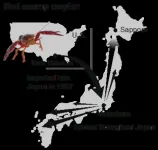(Press-News.org) An international team of researchers has found a genetic variant that may explain why some people of African ancestry have naturally lower viral loads of HIV, reducing their risk of transmitting the virus and slowing progress of their own illness.
Reported today in Nature, this is the first new genetic variant related to HIV infection discovered in nearly 30 years of research. It could, in the future, help direct the development of new treatments approaches for those living with HIV.
HIV remains a major threat to global health. According to UNAIDS, there were 38.4 million people living with HIV globally in 2021. A combination of pre-exposure drugs and medicines that dramatically reduce viral loads has had a major impact on transmission, yet 1.5 million people were newly infected in 2021. And while treatments have improved dramatically since the virus was first identified, 650,000 people still died from AIDS-related illnesses in that year.
Viral load is the amount of a virus in a patient’s system. Higher levels are known to correlate with faster disease progression and increased risk of transmission. But viral load varies widely among infected individuals, influenced by a number of factors including an individual’s genetic makeup.
Most of what we know about the relationship between our DNA and HIV comes from studies among European populations. But given that HIV disproportionately affects people on the African continent – more than 25 million people who are HIV-positive live on the continent – it’s important to better understand the role of genetics in HIV infection in African populations.
To investigate this question, researchers analysed the DNA of almost 4,000 people of African ancestry living with HIV-1, the most common type of the virus. They identified a variant within a region on chromosome 1 containing the gene CHD1L which associated with reduced viral load in carriers of the variant. Between 4% and 13 % of people of African origin are thought to carry this particular variant.
Paul McLaren from the Public Health Agency of Canada’s National Microbiology Laboratory, joint first author, said: “African populations are still drastically underrepresented in human DNA studies, despite experiencing the highest burden of HIV infection. By studying a large sample of people of African ancestry, we’ve been able to identify a new genetic variant that only exists in this population and which is linked to lower HIV viral loads.”
CHD1L is known to play a role in repairing damaged DNA, though it is not clear why the variant should be important in reducing viral load. However, as HIV attacks immune cells, researchers at the University of Cambridge’s Department of Medicine, led by Dr Harriet Groom and Professor Andrew Lever, used stem cells to generate variants of cells that HIV can infect in which CHD1L had either been switched off or its activity turned down.
HIV turned out to replicate better in a type of immune cell known as a macrophage when CHD1L was switched off. In another cell type, the T cell, there was no effect – perhaps surprising since most HIV replication occurs in the latter cell type.
Dr Groom said: “This gene seems to be important to controlling viral load in people of African ancestry. Although we don’t yet know how it’s doing this, every time we discover something new about HIV control, we learn something new about the virus and something new about the cell. The link between HIV replication in macrophages and viral load is particularly interesting and unexpected.”
Co-author Professor Manjinder Sandhu from the Faculty of Medicine at Imperial College London said: “With more than a million new HIV infections a year, it’s clear that we still have a long way to go in the fight against HIV – we are yet to have a vaccine to prevent infection, have yet to find a cure and still see drug resistance emerging in some individuals. The next step is to fully understand exactly how this genetic variant controls HIV replication.”
The research in Cambridge was largely funded by the Medical Research Council. A full list of funders can be found in the research paper.
Reference
McLaren, PJ; Porreca, I; Iaconis, G; Mok, HP, Mukhopadhyay, Sl; Karakoc, E et al. Africa-specific human genetic variation near CHD1L associates with HIV-1 load. Nature; 2 Aug 2023; DOI: 10.1038/s41586-023-06370-4
END
Genetic variant linked to lower levels of HIV virus in people of African ancestry
2023-08-02
ELSE PRESS RELEASES FROM THIS DATE:
An ancient grain unlocks genetic secrets for making bread wheat more resilient
2023-08-02
Building on the Middle East’s reputation as one of the historical birthplaces of cereal crop domestication, a KAUST-led team has compiled the first complete genome map of an ancient grain known as einkorn[1].
The 5.2-billion-letter-long sequence provides a window into the evolutionary origins of different wheat species. It could help farmers and crop breeders to develop bread wheat varieties with enhanced disease resistance, higher yields and improved hardiness.
“By understanding the genetic diversity and evolutionary history of einkorn, researchers can now leverage its potential for future ...
Perinatal depression screening among sexual minority women
2023-08-02
About The Study: The findings of this study suggest that, although sexual minority women are at high risk of postpartum depression, their sexual identities are largely undocumented in medical records, highlighting the need for strategies to measure sexual orientation that can reliably capture this information.
Authors: Leiszle Lapping-Carr, Ph.D., of the Northwestern University Feinberg School of Medicine in Chicago, is the corresponding author.
To access the embargoed study: Visit our For The Media website at ...
Comparative risks of potential adverse events following COVID-19 mRNA vaccination among older adults
2023-08-02
About The Study: In this study of 6.3 million older U.S. adults, the mRNA-1273 (Moderna) vaccine was associated with a slightly lower risk of several adverse events compared with BNT162b2 (Pfizer-BioNTech), possibly due to greater protection against COVID-19. Future research should seek to formally disentangle differences in vaccine safety and effectiveness and consider the role of frailty in assessments of COVID-19 vaccine performance.
Authors: Daniel A. Harris, Ph.D., of the Brown University School of Public Health in Providence, Rhode Island, is the corresponding ...
Moderna is safest, most effective mRNA vaccine against COVID-19 for older adults, study shows
2023-08-02
PROVIDENCE, R.I. [Brown University] — While mRNA vaccines against COVID-19 have been found to be safe and effective for the general population, in-depth evidence about safety and effectiveness for older adults and individuals with chronic health conditions is more limited.
To address that gap, a team led by Brown University researchers conducted the largest head-to-head comparison study of the two mRNA vaccines approved by the U.S. Food and Drug Administration — the Moderna and Pfizer-BioNTech vaccines. The results, published in JAMA Network Open, ...
Fiber optic cables detect and characterize earthquakes
2023-08-02
In California, thousands of miles of fiber optic cables crisscross the state, providing people with internet. But these underground cables can also have a surprising secondary function: they can sense and measure earthquakes. In a new study at Caltech, scientists report using a section of fiber optic cable to measure intricate details of a magnitude 6 earthquake, pinpointing the time and location of four individual asperities, the "stuck" areas of the fault, that led to the rupture.
For several years, Professor of Geophysics Zhongwen Zhan (PhD '14) ...
Potential neuropathic pain treatment shows promise in preclinical tests
2023-08-02
A non-opioid designer molecule for treating chronic neuropathic pain by calming hyperactive pain-sensing neurons in the peripheral nervous system has had promising results in a preclinical study conducted by researchers at Weill Cornell Medicine and the Burke Neurological Institute.
In the study, published Aug. 2 in the British Journal of Anaesthesia, the first-in-class drug conceptualized by lead author Dr. Gareth Tibbs was found to function according to its design at both the molecular level and as an apparently side-effect-free pain reliever in rats.
“With either a single dose or seven days of daily dosing, we saw a significant reversal of neuropathic pain signs in the ...
Learning how to control HIV from African genomes
2023-08-02
“We searched for human genetic variation that associates with spontaneous control of HIV and identified a novel region in the genome that is only variable in populations of African ancestries,” says Professor Jacques Fellay at EPFL’s School of Life Sciences. “We used a combination of computational and experimental approaches to explore the biological mechanism behind the genetic association and provide evidence that the gene CHD1L acts to limit HIV replication in a subset of white blood cells.”
HIV is still a problem
Despite significant advances in treatment and access to therapy, the ...
How the tropical red swamp crayfish successfully invaded the cold regions of Japan
2023-08-02
Owing to human activities and climate change, many animal species have invaded new habitats. Such biological invasion comes with devastating impacts on the local biodiversity and ecosystems. The red swamp crayfish—known to the scientific world as Procambarus clarkii (P. clarkii)— is no exception. P. clarkii is a freshwater crayfish native to the tropical regions of southern USA and northeastern Mexico. After their introduction to different parts of the world, they have become one of the most widespread and invasive animal species. They are known for their adaptability and aggressive behavior that ensure their survival in a wide range of environments, ...
Breast cancer patients with higher BMI more likely to experience heart damage during chemotherapy
2023-08-02
Breast cancer survival rates have improved considerably in the last few decades in Colombia, but factors that increase the likelihood of patients experiencing cardiovascular side effects, like cardiotoxicity, are not well-known or well-treated. A recent study in the North-East region of Colombia found 11.94% of patients with a high BMI being treated for breast cancer at a regional center experienced heart damage, or cardiotoxicity, during chemotherapy. The study will be presented at the American College of Cardiology (ACC) Latin America 2023 Together with Asociación Costarricense ...
Study presents workaround for randomized experiments
2023-08-02
AUSTIN, Texas – A new statistical tool can help researchers get meaningful results when a randomized experiment, considered the gold standard, is not possible.
Randomized experiments split participants into groups by chance, with one undergoing an intervention and the other not. But in real-world situations, they can’t always be done. Companies might not want to use the method, or such experiments might be against the law.
Developed by a researcher at The University of Texas at Austin, the new tool called two-step synthetic control adapts an existing research workaround, known as the synthetic control method.
The ...


